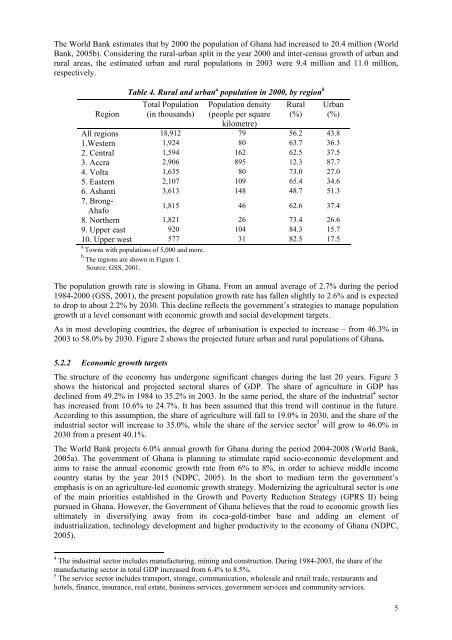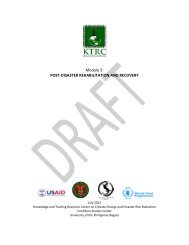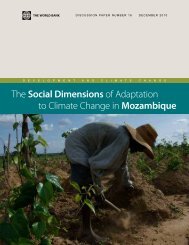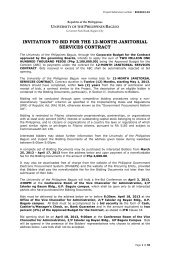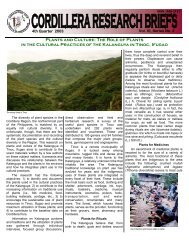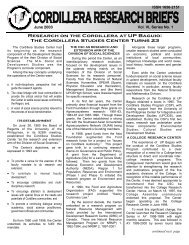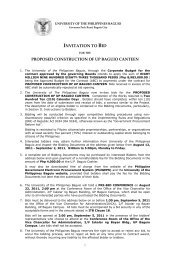Ghana - UNEP
Ghana - UNEP
Ghana - UNEP
- No tags were found...
You also want an ePaper? Increase the reach of your titles
YUMPU automatically turns print PDFs into web optimized ePapers that Google loves.
The World Bank estimates that by 2000 the population of <strong>Ghana</strong> had increased to 20.4 million (WorldBank, 2005b). Considering the rural-urban split in the year 2000 and inter-census growth of urban andrural areas, the estimated urban and rural populations in 2003 were 9.4 million and 11.0 million,respectively.RegionTable 4. Rural and urban a population in 2000, by region bTotal Population(in thousands)Population density(people per squarekilometre)Rural(%)Urban(%)All regions 18,912 79 56.2 43.81.Western 1,924 80 63.7 36.32. Central 1,594 162 62.5 37.53. Accra 2,906 895 12.3 87.74. Volta 1,635 80 73.0 27.05. Eastern 2,107 109 65.4 34.66. Ashanti 3,613 148 48.7 51.37. Brong-1,815 46 62.6 37.4Ahafo8. Northern 1,821 26 73.4 26.69. Upper east 920 104 84.3 15.710. Upper west 577 31 82.5 17.5a Towns with populations of 5,000 and more.b The regions are shown in Figure 1.Source: GSS, 2001.The population growth rate is slowing in <strong>Ghana</strong>. From an annual average of 2.7% during the period1984-2000 (GSS, 2001), the present population growth rate has fallen slightly to 2.6% and is expectedto drop to about 2.2% by 2030. This decline reflects the government’s strategies to manage populationgrowth at a level consonant with economic growth and social development targets.As in most developing countries, the degree of urbanisation is expected to increase – from 46.3% in2003 to 58.0% by 2030. Figure 2 shows the projected future urban and rural populations of <strong>Ghana</strong>.5.2.2 Economic growth targetsThe structure of the economy has undergone significant changes during the last 20 years. Figure 3shows the historical and projected sectoral shares of GDP. The share of agriculture in GDP hasdeclined from 49.2% in 1984 to 35.2% in 2003. In the same period, the share of the industrial 4 sectorhas increased from 10.6% to 24.7%. It has been assumed that this trend will continue in the future.According to this assumption, the share of agriculture will fall to 19.0% in 2030, and the share of theindustrial sector will increase to 35.0%, while the share of the service sector 5 will grow to 46.0% in2030 from a present 40.1%.The World Bank projects 6.0% annual growth for <strong>Ghana</strong> during the period 2004-2008 (World Bank,2005a). The government of <strong>Ghana</strong> is planning to stimulate rapid socio-economic development andaims to raise the annual economic growth rate from 6% to 8%, in order to achieve middle incomecountry status by the year 2015 (NDPC, 2005). In the short to medium term the government’semphasis is on an agriculture-led economic growth strategy. Modernizing the agricultural sector is oneof the main priorities established in the Growth and Poverty Reduction Strategy (GPRS II) beingpursued in <strong>Ghana</strong>. However, the Government of <strong>Ghana</strong> believes that the road to economic growth liesultimately in diversifying away from its coca-gold-timber base and adding an element ofindustrialization, technology development and higher productivity to the economy of <strong>Ghana</strong> (NDPC,2005).4 The industrial sector includes manufacturing, mining and construction. During 1984-2003, the share of themanufacturing sector in total GDP increased from 6.4% to 8.5%.5 The service sector includes transport, storage, communication, wholesale and retail trade, restaurants andhotels, finance, insurance, real estate, business services, government services and community services.5


